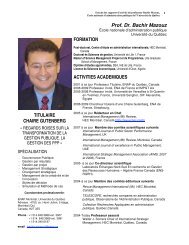Why do firms both make and buy? An investigation of concurrent ...
Why do firms both make and buy? An investigation of concurrent ...
Why do firms both make and buy? An investigation of concurrent ...
You also want an ePaper? Increase the reach of your titles
YUMPU automatically turns print PDFs into web optimized ePapers that Google loves.
296 A. Parmigiani<br />
well balanced by type <strong>of</strong> good <strong>and</strong> sourcing mode.<br />
For example, only three <strong>of</strong> the 169 cases <strong>of</strong> part<br />
coating were produced 100 percent internally <strong>and</strong><br />
only seven <strong>of</strong> the 164 cases <strong>of</strong> die maintenance<br />
were 100 percent outsourced. This is termed a<br />
sparse cell count problem <strong>and</strong>, if left uncorrected,<br />
can bias parameter estimates in multinomial logit<br />
models (Agresti, 1996). By using the 90 percent<br />
cut-<strong>of</strong>f <strong>and</strong> reclassifying a relatively small number<br />
<strong>of</strong> the observations (82 out <strong>of</strong> 805), we can have<br />
more confidence in the multinomial logit models<br />
that compare making, <strong>buy</strong>ing, <strong>and</strong> <strong>concurrent</strong><br />
sourcing.<br />
Independent variables<br />
All <strong>of</strong> the independent variable items were measured<br />
on a seven-point Likert-type scale. Items for<br />
each variable are listed in the Appendix.<br />
Asset specificity. This variable was operationalized<br />
as market thinness, since goods requiring<br />
highly specific assets <strong>of</strong>ten result in a small number<br />
<strong>of</strong> willing suppliers (Williamson, 1985). When<br />
there are few capable suppliers, switching is difficult<br />
<strong>and</strong> costly. Three items relating to this concept<br />
were adapted from prior work <strong>and</strong> included in the<br />
survey (Walker <strong>and</strong> Weber, 1984; Heide <strong>and</strong> Weiss,<br />
1995; Poppo <strong>and</strong> Zenger, 1998).<br />
Volume uncertainty. Volume uncertainty was<br />
measured by asking respondents about forecast<br />
inaccuracies <strong>and</strong> unpredictability in volume patterns.<br />
Two items adapted from prior work were<br />
included on the survey to measure this attribute<br />
(John <strong>and</strong> Weitz, 1988).<br />
Technological uncertainty. This variable<br />
measures the likelihood that technological change<br />
will occur. This industry is fairly mature, so measuring<br />
the likelihood <strong>of</strong> change was more relevant<br />
than measuring its magnitude. Goods based upon<br />
mature technologies <strong>and</strong> stable processes will be<br />
less prone to this form <strong>of</strong> uncertainty as they are<br />
unlikely to change significantly in the future. The<br />
likelihood <strong>of</strong> technological change can refer to the<br />
innovation potential for either the good or the processes<br />
used in its production. Three items from<br />
prior work were adapted to measure this variable<br />
(Heide <strong>and</strong> Weiss, 1995; Bensaou <strong>and</strong> <strong>An</strong>derson,<br />
1999).<br />
Performance uncertainty. While difficulties in<br />
estimating <strong>do</strong>wnstream performance have sometimes<br />
been operationalized in terms <strong>of</strong> complexity,<br />
this is not as relevant in this context. Dies<br />
may consist <strong>of</strong> scores <strong>of</strong> components <strong>and</strong> seemingly<br />
be quite complex, but if the die can be easily<br />
described to suppliers <strong>and</strong> accurately evaluated<br />
for quality, then <strong>do</strong>wnstream performance can be<br />
assured. A better operationalization for this context<br />
measures information asymmetry, such as when<br />
simple inspection techniques are not adequate to<br />
evaluate quality, when production problems occur<br />
that cannot be traced to a specific cause, <strong>and</strong> when<br />
it is difficult to compare goods from different suppliers.<br />
Five items were developed to measure this<br />
attribute, some <strong>of</strong> which were adapted from prior<br />
work (<strong>An</strong>derson <strong>and</strong> Schmittlein, 1984; <strong>An</strong>derson,<br />
Glenn <strong>and</strong> Sedatole, 2000; Bottum, 1992; Dutta<br />
et al., 1995).<br />
Firm <strong>and</strong> supplier scope economies. Scope<br />
economies for the firm will be independent from<br />
those <strong>of</strong> its suppliers since each has its own established<br />
product mix <strong>and</strong> resource base. Two distinct<br />
variables were created to estimate firm <strong>and</strong> supplier<br />
scope economies. Measures reflected the extent to<br />
which overall costs were reduced by producing the<br />
good along with its other products (Dutta et al.,<br />
1995). Firm scope economies were measured by<br />
two items, while supplier scope economies were<br />
measured by one item.<br />
Firm <strong>and</strong> supplier expertise. Variables were created<br />
for <strong>both</strong> firm <strong>and</strong> supplier expertise, reflecting<br />
the extent to which either has considerable<br />
skills <strong>and</strong> capabilities for producing the good <strong>and</strong><br />
an underst<strong>and</strong>ing <strong>of</strong> the underlying technology.<br />
Due to different experience bases, firm <strong>and</strong> supplier<br />
expertise will be independent. Four items<br />
were used for firm expertise <strong>and</strong> five for supplier<br />
expertise; some <strong>of</strong> these items were borrowed or<br />
adapted from prior work (Walker <strong>and</strong> Weber, 1984;<br />
Noordewier, John, <strong>and</strong> Nevin, 1990) <strong>and</strong> others<br />
were original.<br />
Controls<br />
Firm control variables included the number <strong>of</strong><br />
employees <strong>and</strong> firm age since these have <strong>of</strong>ten<br />
been related to greater internalization (Perry,<br />
1989). A binary variable for unionization was also<br />
included, as unionized <strong>firms</strong> may be more likely to<br />
Copyright © 2007 John Wiley & Sons, Ltd. Strat. Mgmt. J., 28: 285–311 (2007)<br />
DOI: 10.1002/smj





